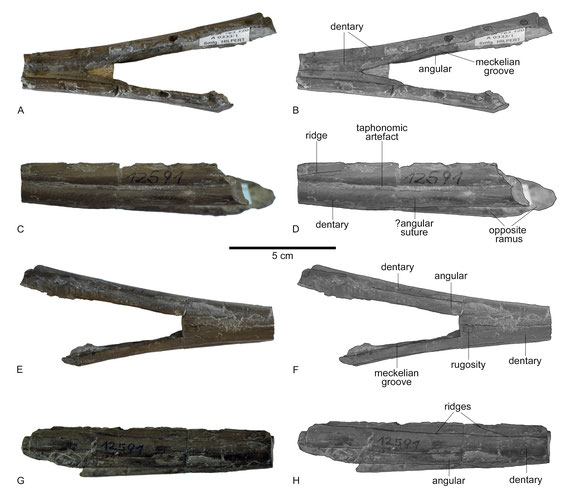Short summary on Abel et al. 2021. An anhanguerian pterodactyloid mandible from the lower Valanginian of Northern Germany, and the German record of Cretaceous pterosaurs. Acta Palaeontologica Polonica.
Me and my colleagues Jahn Hornung (Niedersächsisches Landesmuseum Hannover), Benjamin Kear (Museum of Evolution
Uppsala), and Sven Sachs (Naturkunde-Museum Bielefeld) published a study in Acta Palaeontologica Polonica, in which we describe a new pterosaur fossil from the
Lower Cretaceous of Northern Germany. The specimen (dubbed ‘Essen jaw’, RE 551.763.120 A 0333/1) was found in lower Valanginian strata of the Sachsenhagen clay pit (Lower Saxony) and consists of
a fragmentary mandible. The fossil is housed in the Ruhr Museum, Essen, Germany.
What did we find?
-
Only parts of the dentaries and angulars are preserved. The splenials are lost, exposing the Meckelian groove. The alveoli are well-spaced,
however, none of the teeth are preserved.
- Despite its fragmentary nature, the ‘Essen jaw’ can be roughly classified. Among Early Cretaceous pterosaurs, it can be distinguished from azhdarchoids due to the presence of teeth. It differs further from ctenochasmatoids, boreopterids, dsungaripterids, ‘lonchodectids’, and istiodactyliforms by the spacing and characteristics of the alveoli.
- The specimen can be assigned to Anhangueria due to the well-spaced alveoli in the preserved mandibular section. While it can be distinguished from a number of anhanguerian species, the lack of the often diagnostic jaw tip prohibits any further classification.
The ‘Essen jaw’ (RE 551.763.120 A 0333/1) in dorsal (A-B), left lateral (C-D), ventral (E-F), and right lateral view (G-H). From Abel et al. (2021).
Why is this important?
-
The specimen adds to the sparse record of pterosaurs from the Cretaceous of Germany. Other finds include the holotypes of Ctenochasma
roemeri and Lonchodectes wiedenrothi, the hand imprint Purbeckopus cf. pentadactylus, as well as a number of teeth and other isolated finds. Like the
‘Essen jaw’, all of these finds are highly fragmentary. C. roemeri and the original Purbeckopus imprint are currently lost.
- The ‘Essen jaw’ is further the only known pterosaur find from the Valanginian of Germany. In fact, it is one of only a few described Valanginian pterosaurs in the world.
- Lastly, the ‘Essen jaw’ represents one of the oldest known anhanguerians. The only known anhanguerian of a similar age is Coloborhynchus clavirostris from the upper Berriasian or lower Valanginian of England.
Locality (A), stratigraphy (B), and paleogeographical context of the find (C). From Abel et al. (2021).
What else can be said?
-
The sparseness of Cretaceous pterosaurs from Germany is in stark contrast to the world famous Upper Jurassic
pterosaur fossilsites in the south of the country (notably in the Altmühl valley). It also differs from other well-known Lower Cretaceous strata from elsewhere like the Santana Group (Brazil)
or the Cambridge Greensands (UK). This suggests some kind of bias against the sparse German Cretaceous record.
- The Cretaceous pterosaurs from Germany derive from open marine to lagoonal and fluvial deposits. As most known pterosaurs have been associated with such facies, it is unlikely that there was a paleoecological bias against pterosaurs specific to the German localities. However, a lack of konservatlagerstätten may have hindered the preservation of fragile pterosaur bones.
- Additionally, the Cretaceous strata of Northern Germany have been less mined than the strata of the Altmühl valley, Santana Group, and Cambridge Greensands. Scientific excavation sites are barely present. This implies a major sampling bias.
- At least the low amount of Valanginian pterosaurs could be explained by a global phenomenon. A global cooling interval led to the reduction of carbonate platforms and, hence, likely decreased the amount of depositional environments that would be suitable for the formation of konservatlagerstätten. Likewise, a lack of carbonate platforms could also imply a loss in feeding sites for coastal pterosaurs.

Life restoration of the new anhanguerian pterosaur. By Markus Bühler.
Do you have any questions about this study? Feel free to contact me.
Further reading
Abel, P., Hornung, J.J., Kear, B.P., & Sachs, S. (2021). An anhanguerian pterodactyloid mandible from the lower Valanginian of Northern Germany, and the German record of Cretaceous pterosaurs. Acta Palaeontologica Polonica. doi: 10.4202/app.00818.2020.


